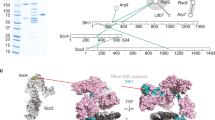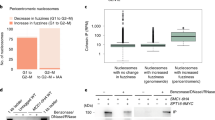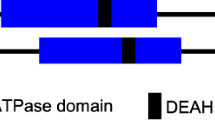Abstract
The cohesin complex is at the heart of many chromosomal activities, including sister chromatid cohesion and transcriptional regulation1,2,3. Cohesin loading onto chromosomes depends on the Scc2–Scc4 cohesin loader complex4,5,6, but the chromatin features that form cohesin loading sites remain poorly understood. Here we show that the RSC chromatin remodeling complex recruits budding yeast Scc2–Scc4 to broad nucleosome-free regions, which the cohesin loader helps to maintain. Consequently, inactivation of either the cohesin loader or the RSC complex has similar effects on nucleosome positioning, gene expression and sister chromatid cohesion. These results show an intimate link between local chromatin structure and higher-order chromosome architecture. Our findings pertain to the similarities between two severe human disorders, Cornelia de Lange syndrome, which is caused by alterations in the human cohesin loader, and Coffin-Siris syndrome, which results from alterations in human RSC complex components7,8,9. Both syndromes can arise from gene misregulation due to related changes in the nucleosome landscape.
This is a preview of subscription content, access via your institution
Access options
Subscribe to this journal
Receive 12 print issues and online access
$209.00 per year
only $17.42 per issue
Buy this article
- Purchase on Springer Link
- Instant access to full article PDF
Prices may be subject to local taxes which are calculated during checkout




Similar content being viewed by others
Accession codes
References
Nasmyth, K. & Haering, C.H. Cohesin: its roles and mechanisms. Annu. Rev. Genet. 43, 525–558 (2009).
Ocampo-Hafalla, M.T. & Uhlmann, F. Cohesin loading and sliding. J. Cell Sci. 124, 685–691 (2011).
Dorsett, D. Cohesin: genomic insights into controlling gene transcription and development. Curr. Opin. Genet. Dev. 21, 199–206 (2011).
Tomonaga, T. et al. Characterization of fission yeast cohesin: essential anaphase proteolysis of Rad21 phosphorylated in the S phase. Genes Dev. 14, 2757–2770 (2000).
Ciosk, R. et al. Cohesin's binding to chromosomes depends on a separate complex consisting of Scc2 and Scc4 proteins. Mol. Cell 5, 243–254 (2000).
Gillespie, P.J. & Hirano, T. Scc2 couples replication licensing to sister chromatid cohesion in Xenopus egg extracts. Curr. Biol. 14, 1598–1603 (2004).
Fryns, J.-P. On the nosology of the Cornelia de Lange and Coffin-Siris syndromes. Clin. Genet. 29, 263–264 (1986).
Krantz, I.D. et al. Cornelia de Lange syndrome is caused by mutations in NIPBL, the human homolog of Drosophila melanogaster Nipped-B. Nat. Genet. 36, 631–635 (2004).
Tsurusaki, Y. et al. Coffin-Siris syndrome is a SWI/SNF complex disorder. Clin. Genet. 85, 548–554 (2014).
Murayama, Y. & Uhlmann, F. Biochemical reconstitution of topological DNA binding by the cohesin ring. Nature 505, 367–371 (2014).
Lengronne, A. et al. Cohesin relocation from sites of chromosomal loading to places of convergent transcription. Nature 430, 573–578 (2004).
D'Ambrosio, C. et al. Identification of cis-acting sites for condensin loading onto budding yeast chromosomes. Genes Dev. 22, 2215–2227 (2008).
Misulovin, Z. et al. Association of cohesin and Nipped-B with transcriptionally active regions of the Drosophila melanogaster genome. Chromosoma 117, 89–102 (2008).
Schmidt, C.K., Brookes, N. & Uhlmann, F. Conserved features of cohesin binding along fission yeast chromosomes. Genome Biol. 10, R52 (2009).
Kagey, M.H. et al. Mediator and cohesin connect gene expression and chromatin architecture. Nature 467, 430–435 (2010).
Lee, T.I. et al. Transcriptional regulatory networks in Saccharomyces cerevisiae. Science 298, 799–804 (2002).
Zhang, H., Roberts, D.N. & Cairns, B.R. Genome-wide dynamics of Htz1, a histone H2A variant that poises repressed/basal promoters for activation through histone loss. Cell 123, 219–231 (2005).
Kasahara, K. et al. Assembly of regulatory factors on rRNA and ribosomal protein genes in Saccharomyces cerevisiae. Mol. Cell. Biol. 27, 6686–6705 (2007).
Pokholok, D.K. et al. Genome-wide map of nucleosome acetylation and methylation in yeast. Cell 122, 517–527 (2005).
Roth, F.P., Hughes, J.D., Estep, P.W. & Church, G.M. Finding DNA regulatory motifs within unaligned noncoding sequences clustered by whole-genome mRNA quantitation. Nat. Biotechnol. 16, 939–945 (1998).
Lee, W. et al. A high-resolution atlas of nucleosome occupancy in yeast. Nat. Genet. 39, 1235–1244 (2007).
Ng, H.H., Robert, F., Young, R.A. & Struhl, K. Genome-wide location and regulated recruitment of the RSC nucleosome-remodeling complex. Genes Dev. 16, 806–819 (2002).
Parnell, T.J., Huff, J.T. & Cairns, B.R. RSC regulates nucleosome positioning at Pol II genes and density at Pol III genes. EMBO J. 27, 100–110 (2008).
Badis, G. et al. A library of yeast transcription factor motifs reveals a widespread function for Rsc3 in targeting nucleosome exclusion at promoters. Mol. Cell 32, 878–887 (2008).
Basehoar, A.D., Zanton, S.J. & Pugh, B.F. Identification and distinct regulation of yeast TATA box–containing genes. Cell 116, 699–709 (2004).
Schawalder, S.B. et al. Growth-regulated recruitment of the essential yeast ribosomal protein gene activator Ifh1. Nature 432, 1058–1061 (2004).
Morohashi, N. et al. Effect of sequence-directed nucleosome disruption on cell-type–specific repression by α2/Mcm1 in the yeast genome. Eukaryot. Cell 5, 1925–1933 (2006).
Hakimi, M.-A. et al. A chromatin remodelling complex that loads cohesin onto human chromosomes. Nature 418, 994–998 (2002).
Baetz, K.K., Krogan, N.J., Emili, A., Greenblatt, J. & Hieter, P. The ctf13–30/CTF13 genomic haploinsufficiency modifier screen identifies the yeast chromatin remodeling complex RSC, which is required for the establishment of sister chromatid cohesion. Mol. Cell. Biol. 24, 1232–1244 (2004).
Huang, J., Hsu, J.-M. & Laurent, B.C. The RSC nucleosome-remodelling complex is required for cohesin's association with chromosome arms. Mol. Cell 13, 739–750 (2004).
Fasulo, B. et al. The Drosophila Mi-2 chromatin-remodeling factor regulates higher-order chromatin structure and cohesin dynamics in vivo. PLoS Genet. 8, e1002878 (2012).
Clapier, C.R. & Cairns, B.R. The biology of chromatin remodeling complexes. Annu. Rev. Biochem. 78, 273–304 (2009).
Du, J., Nasir, I., Benton, B.K., Kladde, M.P. & Laurent, B.C. Sth1p, a Saccharomyces cerevisiae Snf2p/Swi2p homolog, is an essential ATPase in RSC and differs from Snf/Swi in its interactions with histones and chromatin-associated proteins. Genetics 150, 987–1005 (1998).
Liu, J. et al. Transcriptional dysregulation in NIPBL and cohesin mutant human cells. PLoS Biol. 7, e1000119 (2009).
Santen, G.W. et al. Mutations in SWI/SNF chromatin remodeling complex gene ARID1B cause Coffin-Siris syndrome. Nat. Genet. 44, 379–380 (2012).
Takahashi, T.S., Basu, A., Bermudez, V., Hurwitz, J. & Walter, J.C. Cdc7-Drf1 kinase links chromosome cohesion to the initiation of DNA replication in Xenopus egg extracts. Genes Dev. 22, 1894–1905 (2008).
Ocampo-Hafalla, M.T., Katou, Y., Shirahige, K. & Uhlmann, F. Displacement and re-accumulation of centromeric cohesin during transient pre-anaphase centromere splitting. Chromosoma 116, 531–544 (2007).
Wach, A., Brachat, A., Pöhlmann, R. & Philippsen, P. New heterologous modules for classical or PCR-based gene disruptions in Saccharomyces cerevisiae. Yeast 10, 1793–1808 (1994).
Knop, M. et al. Epitope tagging of yeast genes using a PCR-based strategy: more tags and improved practical routines. Yeast 15, 963–972 (1999).
Reid, R.J.D., Sunjevaric, I., Kedacche, M. & Rothstein, R. Efficient PCR-based gene disruption in Saccharomyces strains using intergenic primers. Yeast 19, 319–328 (2002).
Zhong, H., McCord, R. & Vershon, A.K. Identification of target sites of the a2-Mcm1 repressor complex in the yeast genome. Genome Res. 9, 1040–1047 (1999).
Tóth, A. et al. Yeast Cohesin complex requires a conserved protein, Eco1p (Ctf7), to establish cohesion between sister chromatids during DNA replication. Genes Dev. 13, 320–333 (1999).
Rose, M.D., Winston, F. & Hieter, P. Laboratory Course Manual for Methods in Yeast Genetics (Cold Spring Harbor Laboratory Press, Cold Spring Harbor, NY, 1990).
Zhang, Y. et al. Model-based analysis of ChIP-Seq (MACS). Genome Biol. 9, R137 (2008).
Lantermann, A., Strålfors, A., Fagerström-Billai, F., Korber, P. & Ekwall, K. Genome-wide mapping of nucleosome positions in Schizosaccharomyces pombe. Methods 48, 218–225 (2009).
Li, H. & Durbin, R. Fast and accurate short read alignment with Burrows-Wheeler transform. Bioinformatics 25, 1754–1760 (2009).
Gentleman, R.C. et al. Bioconductor: open software development for computational biology and bioinformatics. Genome Biol. 5, R80 (2004).
Irizarry, R.A. et al. Summaries of Affymetrix GeneChip probe level data. Nucleic Acids Res. 31, e15 (2003).
Smyth, G.K. in Bioinformatics and Computational Biology Solutions using R and Bioconductor (eds. Gentleman, R., Carey, V., Dudoit, S., Irizarry, R. & Huber, W.) 397–420 (Springer, New York, 2005).
David, L. et al. A high-resolution map of transcription in the yeast genome. Proc. Natl. Acad. Sci. USA 103, 5320–5325 (2006).
Michaelis, C., Ciosk, R. & Nasmyth, K. Cohesins: Chromosomal proteins that prevent premature separation of sister chromatids. Cell 91, 35–45 (1997).
Chambers, A.L. et al. The INO80 chromatin remodeling complex prevents polyploidy and maintains normal chromatin structure at centromeres. Genes Dev. 26, 2590–2603 (2012).
Acknowledgements
We thank P. Chambers at the Cancer Research UK Genome Variation Laboratory at St. James's University Hospital, Leeds, and N. Matthews from the Advanced Sequencing Facility at the Cancer Research UK London Research Institute for high-throughput sequencing. We thank C. Esnault, A. Lengronne and our laboratory members for discussions and comments on the manuscript. This work was supported by a Beca Postdoctoral del Ministerio de Ciencia y Tecnologia (Spain) and a Marie Curie Intra-European Fellowship (L.L.-S.) and the European Research Council (L.L.-S. and F.U.).
Author information
Authors and Affiliations
Contributions
L.L.-S. conceived, designed and performed the experiments. G.K. performed the statistical analyses. H.P. and A.S. analyzed high-throughput sequencing data sets. F.U. supervised the study. L.L.-S. and F.U. wrote the manuscript.
Corresponding author
Ethics declarations
Competing interests
The authors declare no competing financial interests.
Integrated supplementary information
Supplementary Figure 1 Additional characterization of Scc2–Scc4 binding sites.
(a) Scc2–Scc4 prefers intergenic regions. The fraction of assigned cohesin loader peaks that lie in intergenic regions or in ORFs, and the fraction that these features take up in the S. cerevisiae genome, is depicted. (b) The cohesin loader accumulates at RP gene promoters. Dot plot of Scc2–Scc4 peak to TSS distances for cohesin loader-bound RP genes. (c) The cohesin loader associates with highly expressed genes. The gene expression profiles of Scc2–Scc4–bound genes, divided as to whether they are encoded on the Watson or Crick strand, is compared to that of all other genes. ‘Scc2–Scc4–bound genes’ are the genes that lie closest to each of the 423 Scc2–Scc4 peaks, tRNA genes being excluded from this analysis. The y axis represents probability density of expression as estimated by a Gaussian kernel, the proportion of genes within an expression range is given as the area under the curve above that range. On average, Scc2–Scc4–bound genes are 1.5 fold more highly expressed than all other genes (P < 0.00001; Wilcoxon signed-rank test). (d) Validation by ChIP followed by quantitative real time PCR of five Scc2–Scc4–binding sites. Three negative control sites (N1, N2, N3)12, were analyzed as comparison. Scc2–Scc4 was significantly enriched at the RPL19B promoter compared to the negative control. The means and standard error of three independent experiments are shown. (e) Heat maps of ChIP sequence counts across 423 Scc2-Pk binding sites, normalized as detailed in Online Methods, compared to a control ChIP experiment with the same antibody but using a strain lacking a Pk epitope tag.
Supplementary Figure 2 DNA sequence motif analysis at Scc2–Scc4 binding sites.
The DNA sequence surrounding Scc2–Scc4 binding sites was searched for common sequence motifs using the AlignACE algorithm, as described in Online Methods. Shown are six of the most frequently encountered motifs together with the number of occurrences and the mean offset from the Scc2–Scc4 peak summit ± its variance. Sequence motifs 1 and 2 are oligo(A)-containing motifs, motif 5 is the B-box bound by TFIIIC at tRNA genes, while the origin of motifs 3, 4 and 6 remains unknown.
Supplementary Figure 3 Scc2–Scc4 is recruited to ribosomal gene promoters independently of the transcription factor Fhl1.
(a) RPL34A and RPL19B mRNA levels, relative to total mRNA as quantified by real time PCR, were reduced to less than half in an fhl1Δ strain, as compared to a wild type strain, consistent with results obtained at other ribosomal protein genes26. (b) Scc2 ChIP was performed in parallel in wild type and fhl1Δ strains. Scc2 enrichment at two ribosomal protein gene promoters, and at a tRNA gene as a control, was analyzed by quantitative real time PCR relative to three negative control regions. The means and standard error from three independent experiments are shown.
Supplementary Figure 4 Additional characterization of Scc2 and Sth1 colocalization.
(a) Colocalization of Scc2 and Sth1 is shown using heatmaps as in Figure 3c, but ChIP-Seq counts are depicted centered on the 830 Sth1 peaks. This confirms colocalization of Scc2 with Sth1 at many of the Sth1 binding sites. It suggests that, in addition to the 423 Scc2 binding sites identified by our peak picking algorithm, Scc2–Scc4 peaks that did not meet the peak threshold requirements exist at additional Sth1 binding sites. Strong Sth1 binding often coincides with strong Scc2 binding (and vice versa, compare Figure 3c), so we retained the original selection of 423 strong Scc2–Scc4 binding sites for further analyses. (b) The degree of co-incidence of Scc2 and Sth1 binding within gene promoters, defined as occurrence of a peak’s summit within the 500 bp window immediately prior to a TSS, based on the sacCer3 genome, was tested using a hypergeometric test across all genes, with a null hypothesis that there be no association between the two factors’ binding patterns. The numbers of upstream regions that contain neither, either or both Scc2 and Sth1 peaks is tabulated, and the P value is shown.
Supplementary Figure 5 Nucleosome-free regions at cohesin loading sites are jointly maintained by the Scc2–Scc4 and RSC complexes.
A region around the RPL19B promoter was chosen to display nucleosome and Scc2-ChIP profiles in the indicated strains at 25 °C and 37 °C. The analysis confirms that maintenance of the RPL19B promoter nucleosome-free region, like that at the RPS8B promoter shown in Figure 4a, requires both Scc2–Scc4 and RSC complex function.
Supplementary Figure 6 Genes regulated by Scc2–Scc4 and Sth1 are often bound by Scc2–Scc4.
Venn diagram representing genes either up- or down-regulated greater than 1.5-fold after inactivation of Scc2 or Sth1, respectively, and those that contain an Scc2–Scc4 binding site within 500 bp upstream of the TSS (Scc2–Scc4–promoter). The significance of co-occurrence of genes in the indicated intersections was determined using a hypergeometric test.
Supplementary information
Supplementary Text and Figures
Supplementary Figures 1–6 and Supplementary Tables 1–4 (PDF 2696 kb)
Rights and permissions
About this article
Cite this article
Lopez-Serra, L., Kelly, G., Patel, H. et al. The Scc2–Scc4 complex acts in sister chromatid cohesion and transcriptional regulation by maintaining nucleosome-free regions. Nat Genet 46, 1147–1151 (2014). https://doi.org/10.1038/ng.3080
Received:
Accepted:
Published:
Issue Date:
DOI: https://doi.org/10.1038/ng.3080
This article is cited by
-
The SAGA histone acetyltransferase module targets SMC5/6 to specific genes
Epigenetics & Chromatin (2023)
-
Functional crosstalk between the cohesin loader and chromatin remodelers
Nature Communications (2022)
-
Emerging roles of SWI/SNF remodelers in fungal pathogens
Current Genetics (2022)
-
WAPL maintains a cohesin loading cycle to preserve cell-type-specific distal gene regulation
Nature Genetics (2021)
-
Disruption of NIPBL/Scc2 in Cornelia de Lange Syndrome provokes cohesin genome-wide redistribution with an impact in the transcriptome
Nature Communications (2021)



